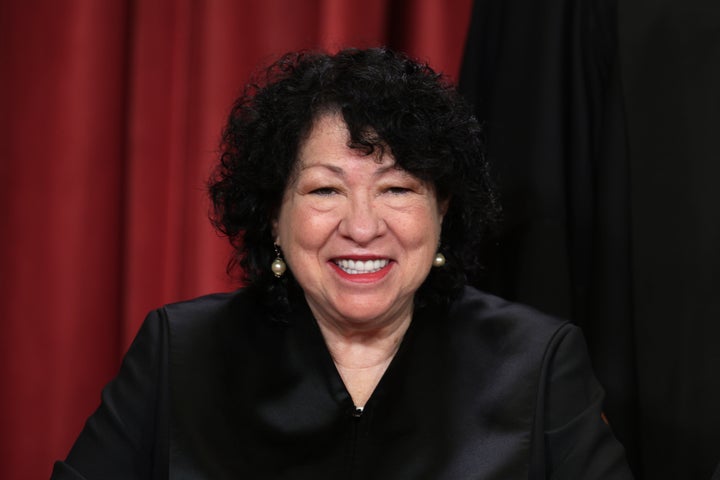
Supreme Court justices have made hundreds of trips and public appearances in recent years. But only one sitting justice appears to have taken the unusual step of traveling with a medic: 69-year-old Justice Sonia Sotomayor.
The revelation comes from newly released U.S. Marshals Service records obtained by the nonpartisan court watchdog Fix the Court, which requested information about security for current and former Supreme Court justices. And it amplifies questions that many only whisper about the long-term fitness of the oldest Democratic-appointed justice on the court.
In February 2018, a medic from Grand Junction, Colorado, accompanied Sotomayor on a trip she made to southern Florida, according to the records.
On a three-day book tour with stops in Illinois and Tennessee in October of that year, the Marshals Service incurred costs for “baggage (medic),” which could refer to medical personnel or be a more benign reference to medical equipment in the justice’s luggage. Sotomayor was diagnosed with Type 1 diabetes at age 7 and gives herself insulin shots multiple times a day.
Both trips occurred after a January 2018 episode in which paramedics treated her at her home for low blood sugar.
In 2021 and 2022, Sotomayor made at least four trips — to Florida, New York and Puerto Rico — in which the Marshals Service mentioned baggage containing “medical gear,” or redacted a description of “baggage/medical supplies.”
The Supreme Court’s press office did not immediately respond to requests for comment.
There are towering stakes for Sotomayor’s ability to remain a Supreme Court justice. At 69, she is beyond conventional retirement age and is the oldest of three Democratic-appointed justices remaining on the court.
Her dissents, with their trademark clarity and righteousness, have made her a favorite of many liberals. But the window in which President Joe Biden and Senate Democrats have an all-but-guaranteed ability to appoint her replacement is rapidly closing. Polls show Biden neck and neck with former President Donald Trump in their likely November rematch, and Democrats face hostile odds of holding on to their slim majority in the Senate, which approves Supreme Court appointments.
Looming over it all is Ruth Bader Ginsburg’s fateful decision not to retire from the court under Democratic President Barack Obama, and the minimal party pressure she faced to do so. When Ginsburg ultimately died in September 2020, with Trump in the White House and only weeks before an election he would lose, Trump seized the opportunity to replace her with her ideological opposite.
Justice Amy Coney Barrett cemented a conservative majority that has gone on to decimate abortion rights and affirmative action, curtail protections for LGBTQ+ rights, and thwart major portions of Biden’s agenda, such as student debt relief.
“It’s fair to point all this out,” said Gabe Roth, the executive director of Fix the Court, which sued to release the documents.
In August, he noted, Sotomayor will have spent 15 years on the court.
“Fifteen years was the average tenure for ... [U.S.] justices for the first 150 years of our republic,” Roth said. “In the last 55 years, that number has now doubled. But the idea that Justice Sotomayor might be considering staying on the court until, I don’t know, Naomi Biden [the president’s granddaughter] is president, is probably not something a lot of folks would want to see.”
But although commentators have made a handful of calls for her to retire, Sotomayor is not facing open pressure from the heart of her party. In 2021, the progressive group Demand Justice hired a billboard truck to circle the Supreme Court with a demand for then-Justice Stephen Breyer — who was in his early 80s — to retire. Last year, Brian Fallon, who headed Demand Justice until joining the White House, said Sotomayor’s age was not a “crisis-level” situation.
The documents Fix the Court obtained come with significant caveats. For one, they are heavily and unevenly redacted.
Sotomayor took the most trips of any justice during the five-year period covered by the newly released documents. The frequency with which she traveled with Marshals raises the likelihood that there would be records capturing her medical needs at a specific point in time but not those of the other current justices, five of whom are also in their 60s or 70s.
For much of 2018, she was crisscrossing the country to promote two children’s books, “Turning Pages: My Life Story” and “The Beloved World of Sonia Sotomayor.” Relative to her busy travel schedule — Sotomayor logged 167 trips from 2018 to 2022, according to Fix the Court — there are only a handful of notations about a medic or medical equipment.
The security requests were filled out by dozens of individuals in different field offices, which could lead to variation in how officials spelled out the justices’ medical needs.
Two justices, John Roberts and Clarence Thomas, do not appear to have relied on the U.S. Marshals Service at all for personal security while vacationing or making speaking appearances. As a result, if either one required medical assistance during their travel, it would not be captured in these documents.
Sotomayor appears to be the only justice for whom security agents are required to wear personal protective equipment, per the documents. But Sotomayor’s caution around COVID-19 due to her preexisting condition is already public knowledge. Sotomayor avoided in-person oral arguments until early 2022, and she was the only justice seen wearing a mask when she returned.
The other mentions of “baggage/medical supplies” or “medic baggage” in the documents refer to post-retirement trips that former Justice Anthony Kennedy took in 2021 and 2022.
The discussion of a liberal justice retiring is almost taboo in certain circles. In 2022, NPR’s longtime Supreme Court reporter Nina Totenberg published a memoir revealing she had been aware of her friend Ginsburg’s declining health. But Totenberg never suggested as much on the air.
As for Sotomayor, privately, Democrats have told reporters they are worried about the optics of pressuring the first Latina justice to step down.
Sotomayor has not hinted publicly at how long she plans to stay on the bench. But she has been frank about her frustrations of being vastly outnumbered by the court’s conservatives.
“Every loss truly traumatizes me,” she told a group of students in January at the University of California, Berkeley. In her dissents, she continued, “I’m really writing for the future, and probably for a different culture.”
